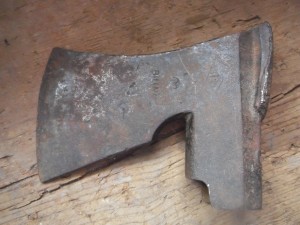There are conflicting sources about this terminology, and perhaps neither is wrong.
"A bearded axe, or Skeggöx (from Old Norse Skegg, beard + öx, axe) refers to various axes, used as a tool and weapon, as early as the 6th century AD. It is most commonly associated with Viking Age Scandinavians. The lower portion of an axe bit is called the "beard" and the cutting edge of the bearded axe extends below the width of the butt to provide a wide cutting surface while keeping the overall weight of the axe low. The hook, or "beard" of the axe would have also been useful in battle, to hook onto things, such as shields or weapons, to pull them out of the defender's grasp... Additionally this design allows the user to grip the haft directly behind the head for planing or shaving wood." --Wikipedia
Wikipedia is admittedly not the best source, but there are plenty of online references to "skeggox" or "bearded axe" that agree with this definition. Searching for "jawed axe" turns up that Beaudry book, and an obscure mention of a jawed axe from Estonia [with no picture], that's about all I found.
More about "bearded axes":
"There were two types of battle-axes used by Scandinavian soldiers. The first was known as the skeggox or bearded axe. It received its name because the bottom of its blade was drawn down toward the haft like a beard.
--The Norwegian Invasion of England in 1066, by Kelly DeVries, page 194
bearded axe: a general style of axe where the lower end or rear corner of the blade, including the heel of the cutting edge, extends considerably beyond the eye or socket thereby permitting the user to grip the handle or half directly above and in line with the cutting edge thereby providing more control when paring or shaving. (common on coach makers axes, goosewing axes and some European style felling axes.)
-- from Glossary at YesteryearsTools.com
None of those sources are experts or accomplished users. Which doesn't mean they are wrong.
I would like to get some opinions from people that actually use the tools. The expert hewers. Especially those from europe.


